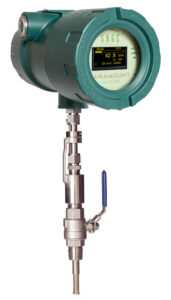At wastewater treatment plants downstream from aeration basins, heated digester tanks are employed to remove and dispose of solid waste. The process also generates digester gas, which may be converted to renewable energy. During this process, measuring and monitoring the gas becomes essential, and a thermal mass flow meter is an appropriate and effective tool.
Monitoring Digester Gas Flow Improves the Operation
In the digestion process at a wastewater treatment facility, bacteria break down biological waste. This process occurs without oxygen—therefore, it is anaerobic digestion. After bacteria have consumed the suspended particles, the solid matter is removed before entering a secondary process where digesters further break down the waste, creating digester gas. Flowmeters monitor digester gas flow in this process to improve overall system balance, efficiency, and operation.
Measuring Digester Gas in Cogeneration and Renewable Energy Processes
The digester gas is mostly methane (CH4) and carbon dioxide (CO2), with compositions typically of 65% methane and 35% carbon dioxide with trace gases. A treatment plant can generate a significant amount of anaerobic digester gas. Since the primary constituent is methane, it offers a source to generate renewable energy to fuel onsite boilers, though excess gas may typically be flared.
At many plants, digester gas is conditioned to use in internal combustion engines to produce electricity for onsite service. In other situations, the digester gas is sold to an outside company for cogeneration production or to create fuel for natural gas-fueled vehicles. Natural gas blending may occur when the digester gas does not sustain the engines’ BTU levels.
Flowmeters are needed to measure the digester gas or biogas in these situations.
EPA and Greenhouse Gas Emission Considerations
The EPA requires greenhouse gas emitters to report annual GHG emissions. In wastewater digester applications, flowmeters are needed for EPA and greenhouse gas emissions considerations, whether monitoring flare gas to comply with environmental regulations or reporting greenhouse gas reduction credits.
Flow Meter Selection Considerations

The anaerobic digester gas (ADG) is dirty and wet and contains contaminants that can accumulate within the piping. When selecting a flow meter for this application, one should consider a meter, such as a thermal mass flow meter with no moving parts, to reduce the cost of maintenance and repair. Some attention may be required to angle the flow probe so that if condensate develops, it flows away from the sensor.
Most wastewater digester gas applications function at low pressure, and thermal flow meters have no pressure drop. The Sage Paramount and Prime have an extremely low-end sensitivity needed to handle the very low flow typical of digester gas. Gas mass flow meters are used throughout the digestion process to optimize it and comply with the EPA regulations (40 CFR Part 98 Subpart II).
Thermal mass flow meters are becoming the preferred choice to monitor and measure GHG emissions. A primary advantage a thermal mass flow meter has over volumetric meters is that it measures mass flow. The SAGE Paramount and Prime have the Sage In-situ Calibration Verification, providing a convenient, onsite, and in-line calibration check complying with EPA requirements.
Related Articles and Guides
- An Industry Guide for Thermal Flow Meters at Wastewater Treatment Plants
- A Guide for Using a Biogas Flow Meter
- Greenhouse Gas Emissions Monitoring Using Thermal Mass Flow Meters (white paper)

